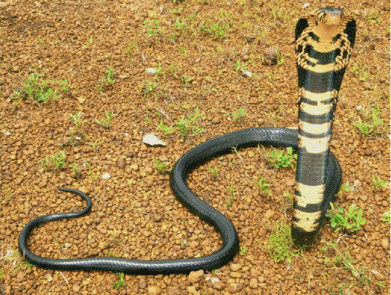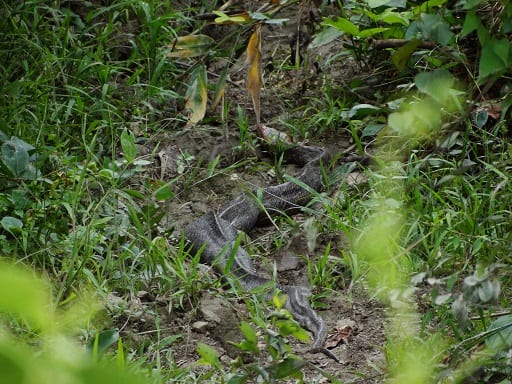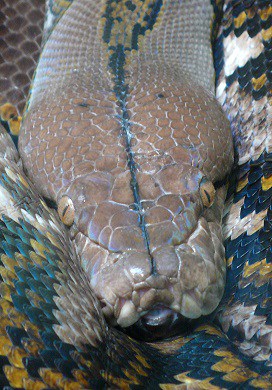| 1 | Viper hides in ant storm |

In 2013, nature mad Michael Lovatt decided to spend an entire month in Costa Rica. He lived in frosty Canada, in B.C.’s sunshine coast, and wanted to see some howler monkeys and giant green vegetation. For 30 days, he didn’t spot a single snake. Two days before his trip ended, he was walking down a gravel road with bright torch in hand. Suddenly, he encountered a 3 metre carpet of red fire ants, blocking his path.
Lovatt pushed ahead, and as he waded through them, he felt an intense pain. His torch revealed 3 bleeding red dots, and the culprit seemed obvious. But when he returned to his cottage, he was already vomiting and experiencing diarrhoea. He suffered a painful, sleepless night, and a visit to a local hospital the next day confined him to a wheelchair. He caught his flight home to Vancouver, but by then, his entire leg was swollen. Lovatt could feel the swelling pushing higher and higher up the limb. He knew something was wrong.
He was rushed to Vancouver General Hospital, where his lips had now begun bleeding. Doctors identified the culprit: not fire ants, but a deadly Bothrops pitviper. The one time a snake had appeared, it had been disguised by a swirling, shifting ant swarm. With antivenom, Lovatt felt improvements within thirty minutes. “If they hadn’t got that anti-venom to me, my kids would have been coming to a funeral to see their dad,” he said.
| 2 | Helicopter drops poisoned mice |

The bird population on the US island of Guam has been devastated since 1952, due to the invasive brown tree snake arriving from Australia. They’ve also knocked out power cables, and Hawaii is fearful of a similar invasion via returning military aircraft. All efforts to eradicate brown tree snakes had failed, and Guam now hosted 2 million. Therefore, 2013 saw a new master plan announced: to rain down dead mice from the sky, each laced with 80mg of acetaminophen. The snakes would greedily eat the dead mice, not telling the difference from live ones, and roll over dead. The mice were attached to cardboard, itself attached to a streamer. This made them perfect for hooking onto the branches the snakes lived on.
Wildlife campaigners such as Peta condemned the “cruel” plan, but by December 2013, the mice helicopters were already on their 4th trip over. Thankfully, other animals were safe. While one mouse bait could kill a snake, 500 were required to kill a pig or dog, and 15 to kill a cat. Acetaminophen is the painkiller more commonly known as paracetamol, but apparently snakes can’t stand it.
Unfortunately, the plan failed, as Guam is still dominated by the invasive snakes as of 2021.
| 3 | 12 foot python spa |

In 2013, one humble spa in Indonesia shot to attention all over the world, when journalists noticed it was offering free snake massages. For $43, shirtless punters would lie back, smile and enter a state of bliss as 3 giant (non-venomous) pythons slithered all over their bodies.
The 3 pythons were washed with antiseptic, dropped onto the man or woman, and largely left to their own devices. The snakes would slither, stick out their forked tongues and arch their necks, with the masseuse only standing by to make sure they didn’t coil up and stop. One accountant claimed that it had cured his long-standing snake phobia, being interviewed while the snakes Jasmine, Muscle and Brown “massaged” him.
The Bali Heritage Reflexology and Spa is located on the tourist island of Bali, with massage rooms in a traditional wooden style. They had 5 pythons, kept in a cage and fed a diet of live rabbits. The spa offered 300 treatments in total, including a relaxing bathtub of beer to bathe in, with a pint of lager to drink. Some said it was cruel, as the snakes’ mouths were taped shut while they massaged, but the spa said that they were treated with adoration.
| 4 | Snake section of brain discovered |

Dogs may have a monopoly on smell, but the human race has extremely sharp vision. With other great apes, we have two forward facing eyes that grant us excellent depth perception. Among mammals, our visual acuity is unparalleled, the ability to establish the size and shapes of objects at any given distance.
In October 2013, researchers announced the cause: an inbuilt, primitive fear of snakes. Scientists examined the pulvinar, a primitive brain region involved with vision. They found that when exposed to images of snakes, neuron activity in the pulvinar showed a clear increase. The brain had an ancient knowledge of snakes, acquired over millions of years. This is something that could have never happened with a picture of an oncoming bus, for example, which has only existed for 100 years. The verdict was that the brain had a tiny corner devoted specifically to snakes.
This ancient recognition was why people instinctively grind to a halt when they see a hissing cobra on a forest trail. Illustrating the theory, the native lemurs of Madagascar have terrible eyesight, and Madagascar has no venomous snakes (dangerous ones anyway).
| 5 | New nasal spray cure invented |

Rushing people to hospital to get antivenom is a big problem in remote villages. People in Africa and India have died before helicopters can fly in, even respected herpetologists. In 2013, Dr Matt Lewin announced a solution: a nasal spray which could be carried in everyone’s pocket. The spray contained the drug neostigmine, which was already recommended for paralysing snakebites.
Lewin’s study consisted of just one 45 year old man, who agreed to be chemically paralysed (presumably for a big bag of cash). The man’s torment lasted just 20 minutes, as a quick sniff relieved all symptoms. Sounds like a stretch, right? However, one of Lewin’s colleagues had already used the nasal spray in the field, on an Indian woman whose face was paralysed by a krait. This woman took 30 minutes to revive.
Just a few milligrams of the spray were required for success. Lewin knew that the World Health Organisation recommended neostigmine in IV form. He also knew that nasal neostigmine was used for myasthenia gravis, a neuromuscular disease, and so he put two and two together. Skeptics pointed out that it wouldn’t prevent blood chaos and haemorrhaging, but supporters argued that in the end, many snakebite deaths arise from lung failure, AKA respiratory paralysis.
| 6 | Snake festival entrances locals |

When August arrived in 2013, it was time yet again for the annual, wildly popular snake worshipping festival of the east Indian village of Purba Bishnupur. The cobras had been caught from the surrounding countryside, and were believed to be representatives of the Hindu goddess Manasa. Snake charmers clapped and played colourful drums, creating an irresistible rhythm that lured the snakes out of their wicker baskets and clay pots.
“It is an art to make the snakes come out of their boxes and baskets” said a 46 year old snake charmer taking part in the festival. Hundreds of Indian locals flocked from all over in a mad frenzy, desperate to get a taste of the snake’s wisdom. One by one, they queued to receive their share of the blessing from the deadly cobras, hoping to guarantee good fortune in the agricultural season to come.
The cobras swayed and lunged in time with the rhythm, to an enraptured audience. A single bite could have wiped them out, yet the people didn’t care, as the snake charmers were “in control”. The only downside to the festival’s immense popularity was that some punters didn’t pay up.
| 7 | Woman gets bitten by wine bottle |

This is today’s zombie snake story, or a simple lesson to never let your guard down. Liu from China’s Heilongjiang Province was a long-time rheumatism sufferer who had finally got sick of the pain. Her husband bought her a traditional remedy – snake wine, which dates back 3000 years and is made from steeping often venomous serpents in rice wine.
Liu spent 3 months marinating the cobra in the remedy, taking daily sips, whenever she felt her symptoms flare up. One day, she opened the lid to top the bottle up with more wine. To her surprise, the cobra bit her. It was clearly still alive, after 90 days in a cramped bottle. Liu’s screams were heard by her husband, who rushed her to the hospital. She was given antivenom and discharged without incident, while the snake was killed.
According to experts, depriving snakes of oxygen can trigger a hibernation-like state, which can keep them alive for extreme lengths of time. The lid probably wasn’t airtight, allowing in just enough oxygen to keep the snake alive. In 2009, a Hong Kong man was bitten by a marinating snake after 2 months. In 2001, a man from Guangxi died when a snake crawled out of a home brew after a whole year.
| 8 | The nationwide Burmese python hunt |

The next phase of the Burmese python eradication campaign kicked off on January 12th 2013, as members of the public were invited to a grand hunt in the Florida everglades. Anyone could take part, resulting in 1600 eager hunters arriving from 38 states. Cash prizes were planned, including $1500 for the most pythons killed and $1000 for the longest python. The hunters were taught to dispatch the pythons humanely, with decapitation or a shotgun blast to the head so that brain activity immediately ceases.
On February 10th, the hunt finished, and the grand total was announced: 68. The Florida everglades were previously estimated to hold 150,000 invasive pythons.
Surprisingly, this was considered to be a great result, as the original target had been only 70. The organisers explained how a Burmese python’s brown-yellow camouflage is second to none, and that hunters can miss a fully grown adult standing right next to themselves. Additionally, February had been warm in Florida, meaning that Burmese pythons were hiding in everglade bush rather than basking in sunlight. Burmese pythons are ambush hunters, which wait motionless for hours. The silver lining was that no native snakes were accidentally killed, and no alligators noticed the massive influx of people from other states.
| 9 | Country hopping doom python |

One viral story in 2013 involved the python from hell. Its victim was a drunk man in the southern Indian state of Kerala, who had downed one beer too many and passed out in the street in an abyss of intoxication. Unfortunately, a python was slithering down the pavement in the opposite direction. It noticed the sleeping man, and decided to sallow him on the spot. An image of a horrifically swollen python lurking on a vehicle’s metallic floor went viral, and the snake was apparently killed to dig out the man’s body.
But investigations revealed something strange. The python had been getting around, as the same image had already been used for stories in South Africa, China, Malaysia and Indonesia. Other victims included another drunk man, and a 4 year old child. The Indonesian tale revolved around the evil python taking advantage of floods which had hit the region.
Nobody knows where the picture originated from, and nobody knows whether there was a man inside the python’s undeniably large belly. Nevertheless, if it can jump the Pacific ocean, then the Atlantic ocean is definitely no barrier.
| 10 | Year of the snake |

February 10th marked the official lunar new year in the Chinese Zodiac Calendar, and this time, the year of the snake had rolled back around. A weekend of celebrations, gluttony and revelling commenced, with crowds gathered at Ditan Temple in Beijing to celebrate. Acrobats were fired out of cannons, and audiences wowed as one snake charmer pushed a snake up his nose, and pulled its tail out his mouth. Young boys wore inflatable snakes on their shoulders, and little girls approached to stroke the snakes, and drape them over their backs. The snake zodiac was predicted to bring financial success and a rich social life.
But snakes are often associated with monsters or curses in Chinese mythology, and many couples were desperately scheduling pregnancies to avoid their child being born that year. Compared to souvenir dragons from 2012, the souvenir snakes weren’t selling as well. People couldn’t shake off the old fears, but there was one group that did pay out – people born in the previous year of the snake.
